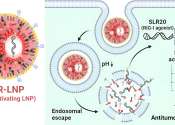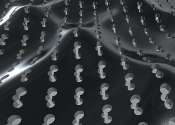New nanoparticles boost immune system in mice to fight melanoma and breast cancer
Vanderbilt researchers have developed a set of nanoparticles that stimulate the immune system in mice to fight cancer and may eventually do the same in humans.
ACS Nano is a monthly, peer-reviewed, scientific journal, first published in August 2007 by the American Chemical Society. The current editor in chief is Paul S. Weiss (University of California, Los Angeles). The journal publishes original research articles, reviews, perspectives, interviews with distinguished researchers, views on the future of nanoscience and nanotechnology. According to the Journal Citation Reports, ACS Nano has a 2010 impact factor of 9.855. The focus of ACS Nano is synthesis, assembly, characterization, theory, and simulation of nanostructures, nanotechnology, nanofabrication, self assembly, nanoscience methodology, and nanotechnology methodology. The focus also includes nanoscience and nanotechnology research - the scope of which is chemistry, biology, materials science, physics, and engineering.

Vanderbilt researchers have developed a set of nanoparticles that stimulate the immune system in mice to fight cancer and may eventually do the same in humans.
Bio & Medicine
15 hours ago
0
39

Dr. Jaeyeon Pyo's team at the Korea Electrotechnology Research Institute (KERI) has become the first in the world to reveal light emission patterns from 3D-printed nanowires, which has been published as a cover article in ...
Nanophysics
Jul 23, 2024
0
50

Successfully innovating optoelectronic semiconductor devices depends a lot on moving charges and excitons—electron-hole pairs—in specified directions for the purpose of creating fuels or electricity.
Nanophysics
Jul 18, 2024
0
37

Snot might not be the first place you'd expect nanobots to be swimming around. But this slimy secretion exists in more places than just your nose and piles of dirty tissues—it also lines and helps protect the lungs, stomach, ...
Bio & Medicine
Jul 17, 2024
0
2

Biopsies are clinical tools commonly used to diagnose a variety of diseases or to monitor tissue for abnormal growth or even rejection of a transplant. During biopsies, tissue samples are removed from the body so they can ...
Bio & Medicine
Jul 16, 2024
0
24

Two-dimensional (2D) materials have unique physical and chemical properties and potential for a wide variety of applications. Peptoids, a type of molecule, compose a class of sequence-defined polymers that mimic biological ...
Nanomaterials
Jul 4, 2024
0
0

The advent of quantum computers promises to revolutionize computing by solving complex problems exponentially more rapidly than classical computers. However, today's quantum computers face challenges such as maintaining stability ...
Nanophysics
Jul 3, 2024
0
126

Optimizing drug delivery systems (DDS) for the biological environment of organs and blood vessels is crucial for maximizing the effectiveness of drug treatment. A research team, affiliated with UNIST has come up with a novel ...
Bio & Medicine
Jul 1, 2024
0
29

Advanced materials, including two-dimensional or "atomically thin" materials just a few atoms thick, are essential for the future of microelectronics technology. Now a team at Los Alamos National Laboratory has developed ...
Nanomaterials
Jun 28, 2024
0
66

Our cells and the machinery inside them are engaged in a constant dance. This dance involves some surprisingly complicated choreography within the lipid bilayers that comprise cell membranes and vesicles—structures that ...
Bio & Medicine
Jun 26, 2024
0
0